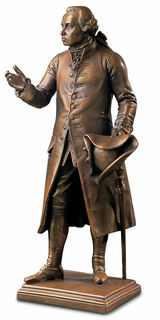Classicism
The Sculpture of Classicism: A Homage to Antiquity
Antiquity was regarded as the great inspiration for Classicism. The art of this epoch, which lasted from around 1760 to 1840, was decisively influenced by the creative traditions of the ancient Greeks and Romans. Artists from the mid-18th century onwards drew inspiration from the art of antiquity for their paintings, sculptures, and architecture. Following the example of the ancient masters, the classicist artists designed the forms of their works in a simple and understated manner. Classicism thus represented a counter-movement to the Baroque style, with its overloaded stylistic idiom and pompous ornamentation. This stylistic shift originated from archaeological finds in Italy and Greece, which led to a reevaluation of ancient art. The German archaeologist, antiquarian and librarian Johann Joachim Winckelmann (1717-1768) played a special role in this process. The picture he portrayed in his writings of Greek and Roman art had a significant impact on the stylistic changes in the visual arts during the Classicism epoch. Famous classicist sculptors include Antonio Canova (1757-1822), Bertel Thorvaldsen (1770-1844), Johann Gottfried Schadow (1764-1850) and Christian Daniel Rauch (1777-1857). Here at ars mundi, you can buy various high-quality replicas from the realm of Classicism sculpture.
Art Serving Beauty: The Classicism Characteristics
For the spiritual father of Classicism, Johann Joachim Winckelmann, the highest task of art was to represent beauty. The only way to achieve this, he believed, was through restrained design or, as he put it, "noble simplicity and quiet grandeur". In this way, he contradicted the contemporary aesthetics of the Rococo and Baroque during the first half of the 18th century. During these epochs, visual artists still worked with many ostentatious decorations and playful ornaments according to the wishes of the royal houses and the clergy. In contrast, the classicist artists distanced themselves from this pompous style of design. Following the example of antiquity, they used clear lines and simple and calm shapes. The works of the classicist epoch now increasingly featured basic geometric shapes such as triangles, circles, spheres, pyramids, columns, or squares. In terms of motifs, the classicist artists emulated the ideal of ancient sculpture and took up figures from religion and mythology. In addition, the veneration of distinguished personalities regained popularity, and numerous rulers, artists and scientists were immortalised in such monuments. Despite all the reduction of the stylistic idiom, Classicism sculpture was crafted with great craftsmanship and technical skill. The sculptures were mainly made of white marble or bronze and were often placed on pedestals, similar to the practices of antiquity.
Buy Classicism Sculpture at ars mundi
Here, at ars mundi, you will find sculptures from the epoch of Classicism. Many of our objects are museum replicas cast in fine artificial marble or bonded bronze. The handcrafted replicas faithfully reproduce the originals. The motifs of the sculptures originate from famous artists of Classicism such as Johann Gottfried Schadow, Antonio Canova and Christian Daniel Rauch. The sculptures depict historical personalities such as Frederick II (Schadow) or Immanuel Kant (Rauch), but also famous motifs such as "The Resting Girl" (Schadow) or "Cupid and Psyche" (Canova). When you buy a classicist sculpture from ars mundi, you are buying a high-quality and decorative art object from one of the most important epochs in art history.









